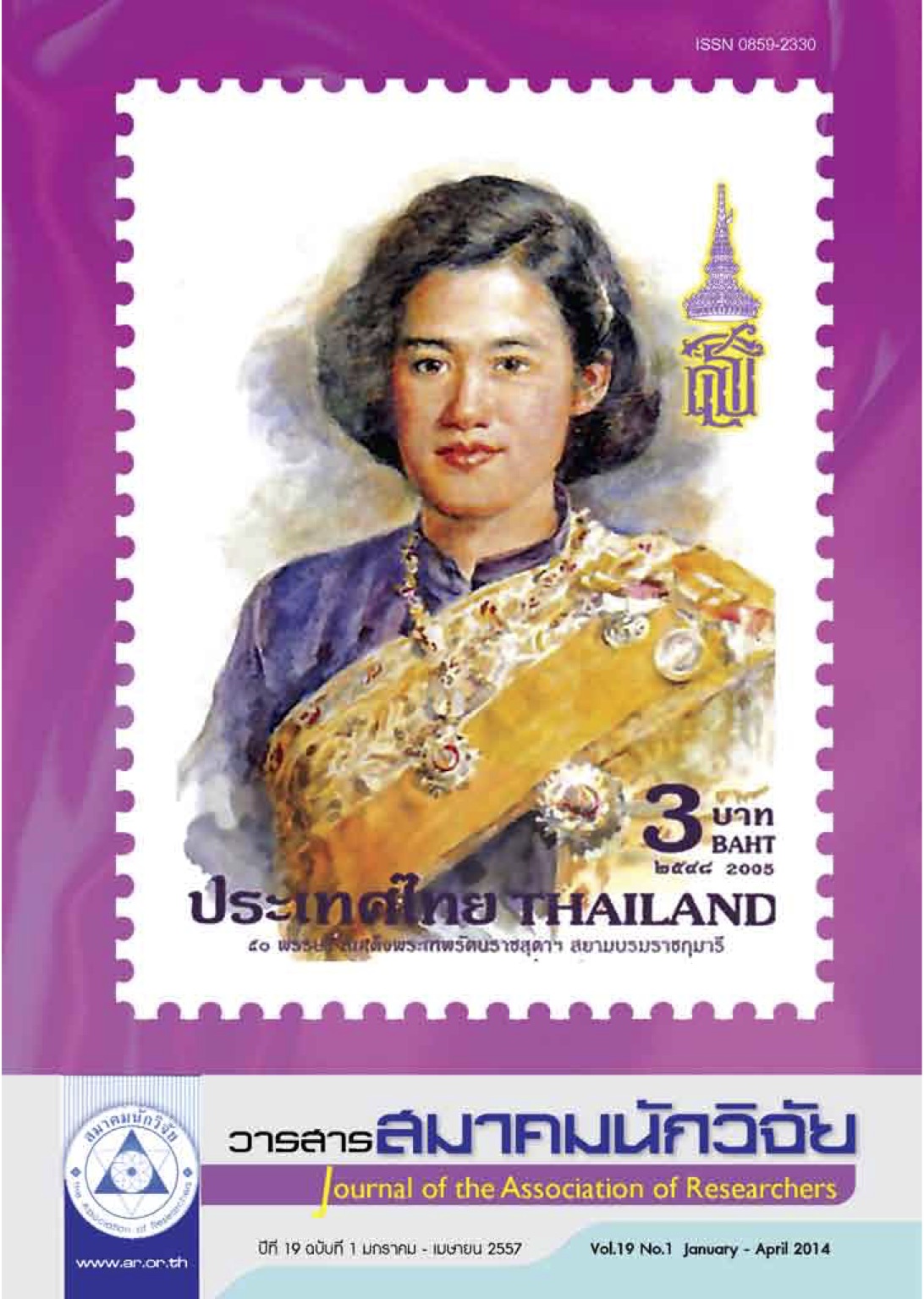THE SUSTAINABLE MARKETING MODEL OF THE SMALL ENTERPRISES IN ACCORDANCE TO SUFFICIENCY ECONOMY PHILOSOPHY
Main Article Content
Abstract
This research aims to (1) analyze the components of the four latent variables of the small enterprise administrators’ characteristics, the environmental factors, the sustainable marketing factors, and the small enterprise achievement related to the Sufficiency Economy Philosophy, (2) analyze both direct and indirect effects of the small enterprise administrators’ characteristics, the environmental factors, and the sustainable marketing factors those affect the small enterprise achievement related to the Sufficiency Economy Philosophy, (3) find the sustainable marketing model of the small enterprises in accordance to the Sufficiency Economy Philosophy. The samples collected were 440. The data were analyzed by using descriptive statistics of percentage, mean and inferential statistics of Confirmatory Factor Analysis, and Structural Equation Modeling (SEM). The research revealed that: (1) Confirmatory Factors Analysis implied that attitude is the most important factor in the small enterprise administrators’ characteristics, technology in the environmental factors, products in the sustainable marketing factors, and customers in the small enterprise achievement related to the Sufficiency Economy philosophy (2) the effect analysis found that the administrators’ characteristics has high and direct effect to the business achievement and high and indirect effect through the sustainable marketing factors. Environmental factors directly affect the business achievement and also indirectly through the sustainable marketing factors in low level. The achievement of small enterprise in accordance to Sufficiency Economy Philosophy should focus on the characteristics of the small enterprise administrators and the sustainable marketing factors related to the Sufficiency Economy Philosophy, (3) the constructed model corresponded with the empirical evidence of all variables
(χ2= 135.52,df = 120, p-value= 0.157, χ2/df =1.129, RMSEA = 0.017)
Article Details
บทความที่ปรากฏในวารสารนี้ เป็นความรับผิดชอบของผู้เขียน ซึ่งสมาคมนักวิจัยไม่จำเป็นต้องเห็นด้วยเสมอไป การนำเสนอผลงานวิจัยและบทความในวารสารนี้ไปเผยแพร่สามารถกระทำได้ โดยระบุแหล่งอ้างอิงจาก "วารสารสมาคมนักวิจัย"
References
กัลยา วานิชย์บัญชา. (2552). สถิติสำหรับงานวิจัย. กรุงเทพฯ: จุฬาลงกรณ์มหาวิทยาลัย.
ฐิติรัตน์ มีมาก, ฉตัรยาพร เสมอใจ และคมกฤช ปติฤิกษ.์ (2552). การจดัการธรุกจิขนาดยอ่ม. กรงุเทพฯ: ซเีอด็ยเูคชนั. เดโชธนโชคจินดา (2550).ปัจจัยความสำเร็จในการดำเนินธุรกิจวิสาหกิจขนาดกลางและ ขนาดย่อม.กรุงเทพฯ: มหาวิทยาลัยเทคโนโลยีพระจอมเกล้าธนบุรี.
นิติ รัตนปรีชาเวช. (2553). ผลการดำเนินงานของวิสาหกิจขนาดกลางและขนาดย่อมจากมุมมองแนวคิดองค์การแห่ง การเรียนรู้และนวัตกรรมองค์การ. วิทยานิพนธ์,รัฐประศาสนศาสตรดุษฏีบัณฑิต, สถาบันบัณฑิตพัฒนบริหารศาสตร์.
ปรียานุช พิบูลสราวุธ. (2549). เศรษฐกิจพอเพียงกับการพัฒนาเศรษฐกิจและสังคม. โครงการวิจัยเศรษฐกิจพอเพียง สำนักงานทรัพย์สินส่วนพระมหากษัตริย์20 กรกฎาคม 2549. กรุงเทพฯ: มหาวิทยาลัยราชภัฎพระนคร.
พิษณุ จงสถิตย์วัฒนา, ธนวรรณ แสงสุวรรณ และ เสาวภา มีถารกุล. (2552). การจัดการการตลาด.มหาวิทยาลัย สุโขทัยธรรมาธิราช. (พิมพ์ครั้งที่ 16). กรุงเทพฯ: โรงพิมพ์น่ำกังการพิมพ์
รัตติกรณ์ จงวิศาล. (2551). ธรรมาภิบาลของวิสาหกิจขนาดกลางและขนาดย่อม. คณะสังคมศาสตร์, มหาวิทยาลัย เกษตรศาสตร์.
สุชิต ผลเจริญ. (2551). กลยุทธ์การตลาดเชิงสัมพันธภาพที่เป็นปัจจัยทำให้ได้เปรียบทางการแข่งขันในอุสาหกรรม น้ำอัดลมของประเทศไทย.วิทยานิพนธ์ บริหารธุรกิจดุษฎีบัณฑิต, มหาวิทยาลัยอิสเทิร์นเอเชีย
สุขสรรค์ กันตะบุตร. (2550). การศึกษาการประยุกต์ปรัชญาของเศรษฐกิจพอเพียงในภาคธุรกิจ. กรุงเทพฯ: มหาวิทยาลัยมหิดล.
สุภมาส อังศุโชติ, สมถวิล วิจิตรวรรณา, และรัชนีกูล ภิญโญภานุวัฒน์. (2552). สถิติวิเคราะห์สำหรับการวิจัยทาง สังคมศาสตร์และพฤติกรรมศาสตร์ : เทคนิคการใช้โปรแกรม LISREL. (พิมพ์ครั้งที่ 3 ฉบับปรับปรุง). กรุงเทพฯ: มิสชั่น มีเดีย.
สำนักงานคณะกรรมการพิเศษเพื่อประสานงานโครงการอันเนื่องมาจากพระราชดำริ. (2551). การประกวดผลงาน ตามปรัชญาเศรษฐกิจพอเพียง. กรุงเทพฯ:โรงพิมพ์อรุณการพิมพ์.
สำนักงานคณะกรรมการพิเศษเพื่อประสานงานโครงการอันเนื่องมาจากพระราชดำริ. (2553). การประกวดผลงาน ตามปรัชญาเศรษฐกิจพอเพียง. กรุงเทพฯ: โรงพิมพ์อรุณการพิมพ์.
อภิชัย พันธเสน, สรวิชญ์ เปรมชื่น, และพิเชษฐ์ เกียรติเดชปัญญา. (2546). การประยุกต์พระราชดำริเศรษฐกิจ พอเพียงกับอุตสาหกรรมขนาดกลางและขนาดย่อม. กรุงเทพฯ: กองทุนสนับสนุนการวิจัย.
เอื้อมพร เธียรหิรัญ. (2552) รูปแบบการจัดการเชิงกลยุทธ์ เพื่อเพิ่มมูลค่าผลิตภัณฑ์ของวิสาหกิจขนาดกลางและ ขนาดย่อม (SMEs) ผ้าคลุมผมสตรีมุสลิมและหมวก กะปิเยาะห์ จังหวัดปัตตานี ยะลา และนราธิวาส บน ฐานแนวคิดปรัชญาเศรษฐกิจพอเพียง. กรุงเทพฯ: มหาวิทยาลัยราชภัฏบ้านสมเด็จเจ้าพระยา.
Barney, J. B. (2002). Gaining and sustaining competitive advantage, (2nd ed.). Upper Saddle River, NJ: Prentice- Hall.
Cheiaropher, P., Low, S., Rory, P., Effie, P. (2011). Developing and Marketing Sustainable Construction Serices. Universiti Teknologi Malaysia (UTM), Malaysia.
Ellinger, A. E., Ketchen Jr, D. J., Hult, G. T. M., Elmadag, A. B., & Richey Jr, R. G. (2007), “Market Orientation, Employee Development Practices, and Performance in Logistics Service Provider Firms.” , Industrial Marketing Management, 37(4), 353-366
Frederick, S. (2005). Cognitive Reflection and Decision Making. Journal of Economic Perspectives, 19(4 Fall), 24-42.
Gimenez, C. & Ventura, E. (2005). Logistics-production, logistics-marketing and external integration: Their impact on performance. International Journal of Operations & Production Management, 25(1), 20-38
Hess, D. (2006). Business Ethics and the Natural Environment. Business Etnics Quarterly.
Hunt, S. D. (2011). Sustainable marketing, equity, and economic growth: A resource-advantage, economic freedom approach. Academy of Marketing Science.
Jensen, M. (2000). A Theory of The Firm: Governance, Residual Claims, and Organizational Forms, Harvard University Press
Kenneth & Donald. (2004). Marketing Management. New York: Prentice Hall International.
Kotler, P. & Armstrong, G. (2009). Principles of Marketing. (13th ed). Upper Saddle River, New Jersey: Pearson
Kotler, P. & Keller, K. (2012). Marketing Management. (14th ed). New Jersey: Prentice-Hall.
Kinoti, M. W. (2011). Green marketing Intervention Strategies and Sustainable Development: A Conceptual Paper. University of Nairobi, School of Business Nairobi, Kenya.
Patiar, A. & Mia, L. (2009). Transformational leadership style, market competition and departmental performance: evidence from luxury hotels in Australia, International Journal of Hospitality Management, 28(2), 254-262.
Poh-Lin Yeoh & Insik Jeong. (1995) “Contingency relationships between entrepreneurship, export channel structure and environment: A proposed conceptual model of export performance”, European Journal of Marketing, 29(8), 95 – 115
Porter, M. (1998). Competitive Advantage: Creating and Sustaining Superior Performance. Free Press.
Palmatier, R. W., Rajiv P. D., Dhruv, G., & Kenneth, R. E. (2006), “Factors influencing the effectiveness of relationship marketing: A meta-analysis,” Journal of Marketing,70 (October), 136-153.
Rosenbloom, B. (2004). Marketing Channel: A Management View. (Seventh Edition) United Kingdom : Thomson/South- Westem.
Schiffman, L. G., Kanuk, L. L. (2007). Consumer behavior. (Ninth edition). Pearson education.
Sergio, O. & Roberto, F. (2007). Market orientation, Knowledge-related resources and firm performance. The University Diego Portales.
Shrikanth, R. & Suryanarayana Raju, D. (2012). Contemporary Green Marketing - Brier Reference to Indian Scenario. Hyderabad, Andhra Pradesh.
Subin. I., Mahmood, H. & Sanjit, S. (2007). The effects of perceived industry competitive intensity and marketing-related capabilities: Drivers of superior brand performance. College of Business, San Francisco State University.


